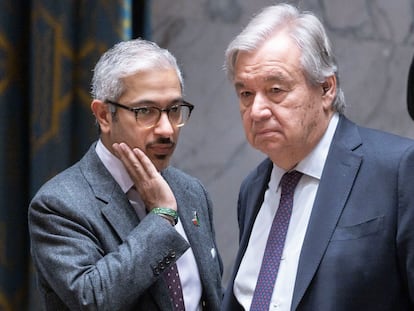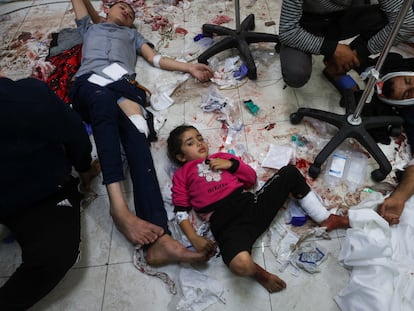War echoes in the oasis of peace where Israeli Jews and Arabs live together
Neve Shalom is the only Israeli village where members of the two communities have chosen to live together. Its neighbors struggle to minimize the impact of the Hamas attack and the war in Gaza on their project.

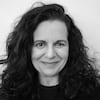
Neve Shalom is like an island of greenery on a hill above the Ayalon Valley, in a land considered a no man’s land between Israel and the West Bank, 35 kilometers west of Jerusalem. It is midday and there is not a soul on the street in this orchard dotted with small houses and gardens with palm trees and bougainvillea. The chatter of birds and the laughter of children arriving from the village school do not disturb the idyllic appearance of the only town where Jews and Palestinians with Israeli citizenship have chosen to live together. Neve Shalom or Wahat as Salam - its name in Arabic - means “oasis of peace”, but the mirage of serenity contained in that name is soon dispelled by the roar of a fighter plane heading for Gaza.
The war that is raging in the Palestinian enclave, 50 kilometers to the south, reverberates in this fiefdom of utopia whose gates used to be closed at night, but are now sealed during the day as well. “After the October 7 attack, we closed the gates to protect ourselves from Hamas. Later, also from Jewish extremists,” explains Eldad Joffe, the 68-year-old chairman of the town’s municipal council. Even before that day and the war in Gaza, this community had suffered acts of hatred. In 2020, Jewish radicals set fire to the building of its School for Peace, a study center that organizes courses and seminars to promote dialogue between Jews and Palestinians. A few days later, the town’s library was burned to the ground. In 2012, several cars were spray-painted with the phrase: “Death to the Arabs”.
The outbreak of the war, which arouses support among the Jewish population that some polls put at close to 90%, accentuates the exceptional nature of this community in a country whose tendency in recent years has been right-wing. Also the normalization of the ultra-right parties in coalition with Prime Minister Benjamin Netanyahu, who advocate the deportation of “disloyal” Arabs from Israel. In barely a quarter of a century, the percentage of the Jewish population that defines itself as right-wing had already risen before October 7 from 40% to 62%, a figure that rises to 70% among young people between 18 and 24 years of age.
Neve Shalom is home to 40 Palestinian Israeli and 40 Jewish families, about 350 people. The children study together until the end of elementary school in a bilingual Arabic-Hebrew program in a school that also welcomes students from Palestinian villages in the West Bank and Jews from nearby Israel. The community, whose organization resembles the cooperative model of the kibbutz, is divided between Arabs and Jews.
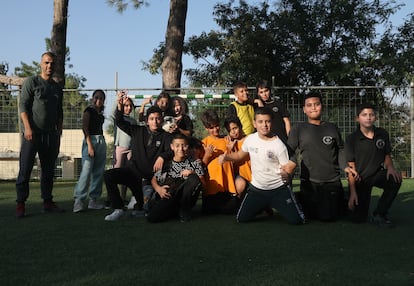
“We are different,” says Nava Sonnenschein, 70, at the village administration offices. “We care about Jews being killed and Palestinians being killed. We feel pain for the Hamas hostages and for the people bombed in Gaza,” she says. Sonnenschein’s family was the second to settle on this hill, in 1979, when it was still a wasteland without sewage, electricity or telephone. “Outside of here,” Eldad adds, “we would not be able to express solidarity with the Palestinians.” Many of the adults living in Neve Shalom are liberal professionals, with a pacifist background or in the dwindling Israeli left.
In Israel, there are other cities of mixed Jewish-Palestinian population, but their conflictive cohabitation has not been a choice, but a result of the conflict. In 1948, after the creation of Israel and the first Arab-Israeli war, the minority of Palestinians who did not flee or were expelled during the Nakba (the forced exodus), continued to live in cities such as Nazareth, Acre, Lod and Jaffa, among others. These “Palestinians of ‘48″ - as they are known - who later acquired Israeli nationality, constitute 21% of the population. On paper, they have the same rights as Jews, such as the right to vote. In reality, they suffer structural discrimination.
In the oasis of peace of Neve Shalom, “relations between the two communities have not worsened” since October 7, says its founder. Neighbors have since held meetings to try to deal with the grief over the Hamas attack and the war in Gaza. The village’s School for Peace has also collaborated “with local human rights organizations calling to avoid harming civilians on both sides,” says a document from the school provided by Roi Silberberg, director of its School for Peace, which criticizes both the “atrocities committed by Hamas” and Israel’s “lethal and vindictive response” in Gaza.
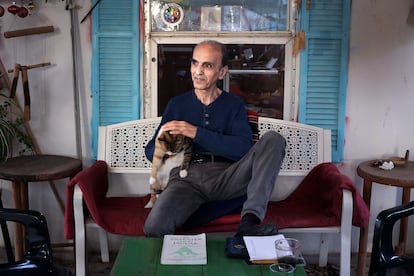
Pain
The sight of civilians with automatic rifles on their shoulders, common in Israel, is unthinkable in Neve Shalom, but the village is not an Eden alien to its surroundings, nor are its inhabitants immune to a polarization that the war has accentuated. Rayek Rizek sits surrounded by cats in the courtyard of the café he runs in the village, where he has lived for almost 40 years. An Orthodox Christian born in Nazareth, Rizek is a “Palestinian of ‘48″, but his Israeli nationality is for him “a piece of paper”. His memories are a story of pain, which he unravels while the Israeli planes do not stop thundering. The 68-year-old points in two opposite directions: “They take off from a base 15 kilometers away. They go to Gaza and to the Lebanese border”.
A girl enters, greets him in Hebrew and takes a soda from a vending machine. Rizek answers her and then praises that all his neighbors “recognize the Israeli occupation” of the Palestinian territories. He then admits that, since the day of the Hamas attack, he barely speaks “to anyone” in the village. “What happened on October 7 didn’t start that day. Israel has massacred us for decades and perpetrated crimes as heinous as Hamas’. And still some come here to ask me if it is true that Hamas is preventing Gaza civilians from fleeing south, as Israel says!” he is outraged.
Not far away, Orr, 40, looks after her two daughters and a friend of the girls. The eldest, 10, says, over ice cream, that it’s “fun to study Arabic and have Palestinian friends.” Orr opens her eyes wide when asked if she invites Palestinian children to her daughters’ birthdays: “Sure!”.
This mother defines her village as “a bubble”. When the children finish primary school, they have to attend secondary schools outside the village. At 18, they face what Nava Sonnenschein calls a “dilemma”: compulsory military service for men and women, from which Israeli Arabs are exempt. Jews who have grown up in this pacifist community can be sent to bomb Gaza or to intelligence units by speaking Arabic.
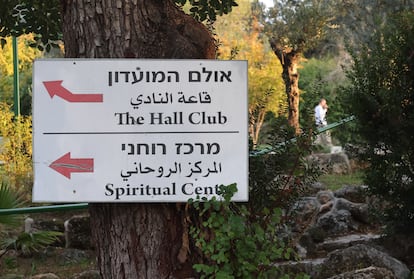
Another woman approaches Orr. She immediately begins to justify the Gaza war with a speech similar to the official one. When asked about the at least 17,000 deaths caused by the Israeli military offensive - according to data from the Strip’s health authorities - she maintains that Israel “tries to protect civilians, whom Hamas uses as human shields.” “Tell me what else we can do. We are defending ourselves,” he concludes.
Night falls over Neve Shalom and Neriya Mark appears driving a small utility vehicle. “Sometimes the earth shakes” from the shelling in Gaza, the 35-year-old laments. Mark was born here, educated at the local school and speaks Arabic. She has a two-year-old son and is pregnant with her second. She lives above her parents’ house, a cozy dwelling where she offers coffee, while the dog Maga scampers under the table. “Not everyone here is a pacifist,” deplores this Israeli.
Neve Shalom was born as a model, but attempts to establish similar villages have failed, mainly because Arabs are almost always prevented from acquiring land. “This village was made possible because the land belonged to the Catholic Church,” explains Eldad Joffe. The community was founded on land initially leased from the nearby Latrun monastery by Bruno Hussar, a priest of Jewish descent who converted to Catholicism. For its critics, the failure of this place is that it remains an exception. Roi Silberberg, director of its School for Peace, qualifies that the “objective of the village is to exist”. In the pages of The Anteater and the Jaguar, the book that Rayek Rizek wrote about this place, we read that these people do not seek utopia, but “to move towards a better world”.
Sign up for our weekly newsletter to get more English-language news coverage from EL PAÍS USA Edition
Tu suscripción se está usando en otro dispositivo
¿Quieres añadir otro usuario a tu suscripción?
Si continúas leyendo en este dispositivo, no se podrá leer en el otro.
FlechaTu suscripción se está usando en otro dispositivo y solo puedes acceder a EL PAÍS desde un dispositivo a la vez.
Si quieres compartir tu cuenta, cambia tu suscripción a la modalidad Premium, así podrás añadir otro usuario. Cada uno accederá con su propia cuenta de email, lo que os permitirá personalizar vuestra experiencia en EL PAÍS.
¿Tienes una suscripción de empresa? Accede aquí para contratar más cuentas.
En el caso de no saber quién está usando tu cuenta, te recomendamos cambiar tu contraseña aquí.
Si decides continuar compartiendo tu cuenta, este mensaje se mostrará en tu dispositivo y en el de la otra persona que está usando tu cuenta de forma indefinida, afectando a tu experiencia de lectura. Puedes consultar aquí los términos y condiciones de la suscripción digital.
More information
Archived In
Últimas noticias
Most viewed
- Sinaloa Cartel war is taking its toll on Los Chapitos
- Oona Chaplin: ‘I told James Cameron that I was living in a treehouse and starting a permaculture project with a friend’
- Reinhard Genzel, Nobel laureate in physics: ‘One-minute videos will never give you the truth’
- Why the price of coffee has skyrocketed: from Brazilian plantations to specialty coffee houses
- Silver prices are going crazy: This is what’s fueling the rally
